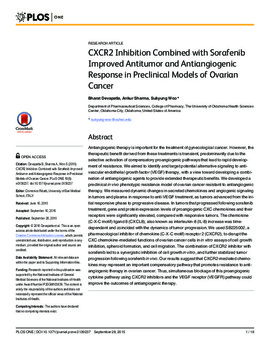| dc.contributor.author | Bharat Devapatla | |
| dc.contributor.author | Ankur Sharma | |
| dc.contributor.author | Sukyung Woo | |
| dc.date.accessioned | 2017-03-05T22:55:20Z | |
| dc.date.available | 2017-03-05T22:55:20Z | |
| dc.date.issued | 2015-09-28 | |
| dc.identifier.citation | Devapatla B, Sharma A, Woo S (2015) CXCR2 Inhibition Combined with Sorafenib Improved Antitumor and Antiangiogenic Response in Preclinical Models of Ovarian Cancer. PLoS ONE 10(9): e0139237. doi:10.1371/journal.pone.0139237 | en_US |
| dc.identifier.uri | https://hdl.handle.net/11244/49278 | |
| dc.description | The authors thank Drs. Kar-Ming Fung and Muralidharan Jayaraman, and Ms. Sheeja Aravindan for their help with the IHC experiments. The authors also thank the OUHSC Histology and Molecular Imaging Cores for their service and technical assistance. | en_US |
| dc.description | | en_US |
| dc.description.abstract | Antiangiogenic therapy is important for the treatment of gynecological cancer. However, the therapeutic benefit derived from these treatments is transient, predominantly due to the selective activation of compensatory proangiogenic pathways that lead to rapid development of resistance. We aimed to identify and target potential alternative signaling to anti-vascular endothelial growth factor (VEGF) therapy, with a view toward developing a combination of antiangiogenic agents to provide extended therapeutic benefits. We developed a preclinical in vivo phenotypic resistance model of ovarian cancer resistant to antiangiogenic therapy. We measured dynamic changes in secreted chemokines and angiogenic signaling in tumors and plasma in response to anti-VEGF treatment, as tumors advanced from the initial responsive phase to progressive disease. In tumors that progressed following sorafenib treatment, gene and protein expression levels of proangiogenic CXC chemokines and their receptors were significantly elevated, compared with responsive tumors. The chemokine (C-X-C motif) ligand 8 (CXCL8), also known as interleukin-8 (IL-8) increase was time-dependent and coincided with the dynamics of tumor progression. We used SB225002, a pharmacological inhibitor of chemokine (C-X-C motif) receptor 2 (CXCR2), to disrupt the CXC chemokine-mediated functions of ovarian cancer cells in in vitro assays of cell growth inhibition, spheroid formation, and cell migration. The combination of CXCR2 inhibitor with sorafenib led to a synergistic inhibition of cell growth in vitro, and further stabilized tumor progression following sorafenib in vivo. Our results suggest that CXCR2-mediated chemokines may represent an important compensatory pathway that promotes resistance to antiangiogenic therapy in ovarian cancer. Thus, simultaneous blockage of this proangiogenic cytokine pathway using CXCR2 inhibitors and the VEGF receptor (VEGFR) pathway could improve the outcomes of antiangiogenic therapy. | en_US |
| dc.language.iso | en_US | en_US |
| dc.publisher | PLos One | |
| dc.relation.ispartofseries | PLoS ONE 10(9): e0139237 | |
| dc.relation.uri | http://www.plosone.org/article/info%3Adoi%2F10.1371%2Fjournal.pone.0139237 | |
| dc.rights | Attribution 3.0 United States | |
| dc.rights.uri | https://creativecommons.org/licenses/by/3.0/us/ | |
| dc.subject | Cancer treatment,Ovarian cancer,Chemokines,Angiogenesis,Tumor angiogenesis,Cytokines,Immunohistochemistry techniques,Mouse models | en_US |
| dc.title | CXCR2 Inhibition Combined with Sorafenib Improved Antitumor and Antiangiogenic Response in Preclinical Models of Ovarian Cancer | en_US |
| dc.type | Research Article | en_US |
| dc.description.peerreview | Yes | en_US |
| dc.description.peerreviewnotes | http://www.plosone.org/static/editorial#peer | en_US |
| dc.identifier.doi | 10.1371/journal.pone.0139237 | en_US |
| dc.rights.requestable | false | en_US |

